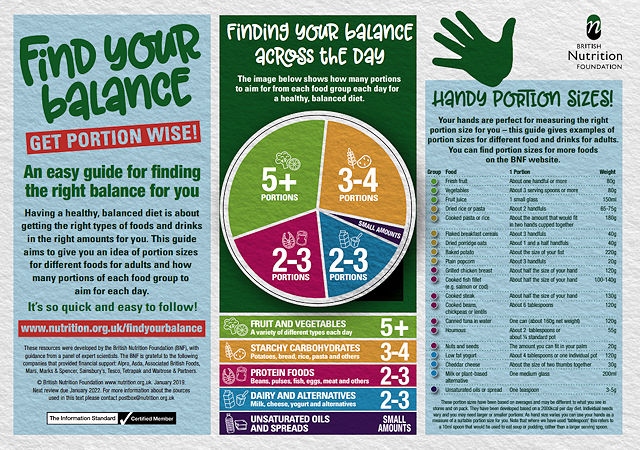Hand and spoon measurements help with portion sizes
Date published: 16 January 2019

Photo: Photos.com
Hands
The British Nutrition Foundation (BNF) has launched a practical guide to portion sizes: Find Your Balance, to help us understand not just which foods to eat, but how often and in what quantities, in order to maintain a healthy weight and have a balanced diet.
The guide uses simple hand and spoon measurements to help us estimate appropriate portions, when cooking and serving food. It is designed to complement the Government’s Eatwell Guide, which provides guidance on the proportions of the main food groups that make up a healthy diet.
In order to provide practical ways of estimating these portions without having to weigh out foods, the BNF devised easy to use measures for most foods, based on hands or spoons.
For example:
- 2 handfuls of dried pasta shapes or rice (75g)
- A bunch of spaghetti the size of a £1 coin, measured using your finger and thumb (75g)
- A baked potato about the size of your fist (220g)
- About 3 handfuls of breakfast cereal (40g)
- A piece of grilled chicken breast about half the size of your hand (120g)
- A piece of cheddar cheese about the size of two thumbs together (30g)
- About 1 tablespoon of peanut butter (20g)
- About 3 teaspoons of soft cheese (30g)
Bridget Benelam, Nutrition Communications Manager at the British Nutrition Foundation, said: “More often than not, portion size is not something people give much thought to.
“The amount we put on our plate typically depends on the portion sizes we are used to consuming, how hungry we feel and how much is offered as a helping at a restaurant table or in a packet/ready meal.
“Nonetheless, in order to maintain a healthy weight, we should ensure that our diets contain the right balance of foods, in sensible amounts. This isn’t just about eating less; it’s also about eating differently.”
Within its portion size guide, the BNF has advised how often the suggested portions of foods from different food groups should be eaten during the day, and demonstrates how to put this into practice with an example meal plan.
The food groups include:
- Fruit and vegetables – 5+ portions per day
- Starchy carbohydrates – 3-4 portions per day
- Protein foods – 2-3 portions per day
- Dairy and alternatives – 2-3 portions per day
- Unsaturated oils and spreads – small amounts

Alexandra Preston, Head of Healthy Hearts at Heart Research UK said: “It’s long been known that portion sizes are so important when it comes to eating healthily. We need to make sure that, as well as eating the right foods, we’re eating the right amounts.
“Practical, accessible guidelines that can be adopted and understood by everyone are really helpful. We welcome any initiatives that can help people make healthier decisions to improve their heart health and their overall lifestyles.
You can access the BNF’s handy guide to portion sizes here:
Do you have a story for us?
Let us know by emailing news@rochdaleonline.co.uk
All contact will be treated in confidence.
Most Viewed News Stories
- 1Royton haulage firm fined after Rochdale dad went to work and didn’t come home
- 2Six men arrested in Rochdale child exploitation investigation
- 3Suspended council candidate was ‘politically naive’ for appearing in George Galloway video, leader...
- 4Rochdale church to host Camerados public living room
- 530 years of the GEM Appeal, a Rochdale-founded charity that has raised millions and changed the...
To contact the Rochdale Online news desk, email news@rochdaleonline.co.uk or visit our news submission page.
To get the latest news on your desktop or mobile, follow Rochdale Online on Twitter and Facebook.


